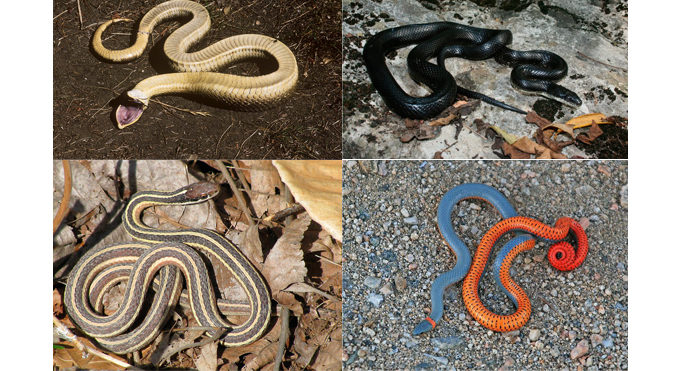
by Dell Cullum

The best part of speaking with folks about wildlife is correcting many of the rumors or misinformation that easily spreads, and ultimately hurts both those who seek understanding and the mistakingly misunderstood animals themselves. Not only does no one benefit from this, but folks are also deprived of getting a deeper enjoyment from nature, by senselessly fearing what they never really knew or understood due to the confusion of misinformation.
I think many folks would agree, that no creature is more feared or misunderstood than the snake. I will say, there are many species of snakes that warrant your fear, but the fear of being led to believe misinformation is much more venomous. I will begin this column by assuring you all right from the start, that here on the eastern end of Long Island we do not have venomous snakes. At least none that you need worry about. But wait, what does that mean? Let me explain…
The garter snake, often referred to as garden snake, is one of the more common snakes here on the east end of Long Island. It’s actually named after the garter that is worn around a woman leg, not the fact that they are often discovered patrolling ones garden. An interesting fact about the garter snake is, although it is harmless to humans, the snake is capable of a bite that produces a neurotoxic venom. The reason it is not threatening to humans is, rather than releasing the venom in one large transmission through hypodermic fangs (like vipers for example), their small teeth must chew and grind for even a small amount of venom to be transferred to the receiving victim. This method works just fine on reducing movement while consuming small prey animals. Note as well, that neurotoxin venom is much more deadly than the other two venom types and quickly acts on the nervous system and brain.
The other two types of venom are Proteolytic venom, which is a Cytotoxin that destroys body cells like cardio toxins, mycotoxins and nephrotoxins, all types of snake toxins that affect specific types of cells. And last, but not at all least, Hemotoxin venoms. This affects the heart and cardiovascular system, and is the most common venom among venomous snakes in America. In fact, only the Coral snake of southern Florida and the Texas Coral snake of southern Texas can kill a human with a neurotoxic bite; however, again it’s not that easy as the snake is very small in size and must also chew on the victim long enough to transmit the appropriate amount of venom to induce death. A rattlesnake is an entirely different story, but since we don’t have rattlesnakes here on the east end, I’ll save that species discussion for another time.
Another misconception about snakes are, they are wet and slimy. In truth, they are dry and smooth. If any sensation pops out, it’s that a snakes body temperature is cool and why not, after all they are cold blooded reptiles. Another snake we often see around our homes is the eastern milk snake. This is another snake that got its name from a fictitious rumor. In this critters case, it was once believed that the milk snake would attached their mouths to the udders of cows and steal the farmers milk. There are several types of milk snakes across the country, each with their own beautiful pattern. They are a sub species of king snake which are also recognized by their very and various colorful appearances. Our eastern milk snake has a beautiful brown and tan pattern outlined in black. They have a black and white checkered belly with a very noticeable “Y” patterned on the top of their head. They are completely harmless and great to have around your property to manage rodent and insect issues. Most all local snakes perform the same beneficial function, and folks are better off coexisting with them, rather than not.
In our country, the easiest way to identify if a snake is venomous or not is simply by looking them in the eye. Venomous snakes have pupils that resemble a cat, and are not circular. A non-venomous snake will have round pupils. One of my all time favorite snakes most commonly found on our beach dunes or in sandy locations, is the unique and entertaining eastern hognose snake. The hognose has three methods of defending itself against potential predators. Its first warning is to mimic the actions of a rattlesnake. The hognose already has the body patterns similar to a rattlesnake, yet it lacks the buttons on the tail end that create the rattlesnakes rattle. In an attempt to fool its enemy, it coils itself up and silently rattles its buttonless tail to mimic the deadly viper. If that doesn’t persuade the the threat to leave, it will then flatten its neck, open its mouth real wide, hiss loudly and impersonate a cobra. Most humans are long gone by now, but the persistent predator get’s the grand finale if they haven’t gotten the hint. If all else fails, the hognose will fall into a state of tonic immobility, much like that of the Virginia Opossum, and literally “play dead”. This is followed by foaming at the mouth and emitting a most foul rancid secretion, whose smell usually seals the deal in becoming non-edible prey.
Another little beauty with a unique defensive move is the ring-necked snake. When threatened, this pencil thin cutie coils up the last third of its body and tail exposing its brilliant red underside against its black upper side. With a small ring around its neck, it is easily identified.
Now, although I’ve told you there is no need to worry about venomous snakes here on the east end of Long Island, there is a need for folks to be aware, and use general care and common sense when coming upon a snake in any circumstance. I do not recommend just grabbing any snake by hand if you’re not sure what kind of snake your grabbing on to. We also have black rat snakes and water snakes in our area and they can be a lot more aggressive then the more common garden variety snake. Water snakes, that frequently live around water bodies like ponds, lakes, brooks, streams, marsh and wetlands can be quick to bite if one attempts to grab it while retreating. No snake, at any time, will ever chase you. They will always retreat unless cornered or grabbed, at which point they react like any other living creature, including humans, and act in defense. Black rat snakes are more often found where rat populations are present, like farms, horse stables, sheds and structures used for storage. Although rat snakes are the best deterrent against rats, they do grow from 40 to 70 inches and will give a good bite if cornered or grabbed. Their bigger size comes with bigger teeth, and although they are not venomous they can still leave a nasty cut which will require a good cleaning and possibly a doctors inspection.
Ultimately the pros clearly outweigh the cons when it comes to the benefits of coexisting with snakes. They do not prefer living inside your home and often get there strictly by accident. Where they do reside, they will absolutely manage both insect and rodent control and leave no noticeable or toxic dropping behind. They will not harm or attack humans or pets that do not disturb them first, and are never a venomous threat.
Snakes are part of our beautiful family of exquisite wildlife, and remember, ALL Wildlife Matters!
~ Dell Cullum
Evelyn Alexander Wildlife Rehab and Rescue: 631-728-WILD
Hampton Wildlife: 631-377-6555

